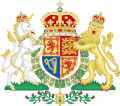| Lord High Constable of England | |
|---|---|
Admiral Sir Tony Radakin with the Lord High Constable's baton at the coronation of Charles III and Camilla in 2023 | |
| Type | Great Officer of State |
| Appointer | The Monarch |
| Term length | At His Majesty's pleasure |
| Formation | 1139 |
| First holder | Miles of Gloucester, 1st Earl of Hereford |
The Lord High Constable of England is the seventh of the Great Officers of State, [1] ranking beneath the Lord Great Chamberlain and above the Earl Marshal. [2] This office is now called out of abeyance only for coronations. The Lord High Constable was originally the commander of the royal armies and the Master of the Horse. He was also, in conjunction with the Earl Marshal, president of the court of chivalry or court of honour. In feudal times, martial law was administered in the court of the Lord High Constable. [1]
Contents
- Lord High Constables of England, 1139–1521
- Lord High Constables of England, 1522–present
- See also
- References
The constableship was granted as a grand serjeanty with the Earldom of Hereford by the Empress Matilda to Miles of Gloucester, and was carried by his heiress to the Bohuns, earls of Hereford and Essex. They had a surviving male heir, and still have heirs male, but due to the power of the monarchy the constableship was irregularly given to the Staffords, Dukes of Buckingham; and on the attainder of Edward Stafford, 3rd Duke of Buckingham, in the reign of Henry VIII, it became merged into the Crown. [1] Since that point it has not existed as a separate office, except as a temporary appointment for the coronation of a monarch or in the event of a trial by combat (albeit only one pro tempore appointment was made in such circumstances, in 1631, and the trial subsequently did not take place); [3] in other circumstances the Earl Marshal exercises the traditional duties of the office. [1] [4]
The Lacys and Verduns were hereditary constables of Ireland from the 12th to the 14th century; and the Hays, earls of Erroll, have been hereditary Lord High Constables of Scotland from early in the 14th century. [1] [5]



